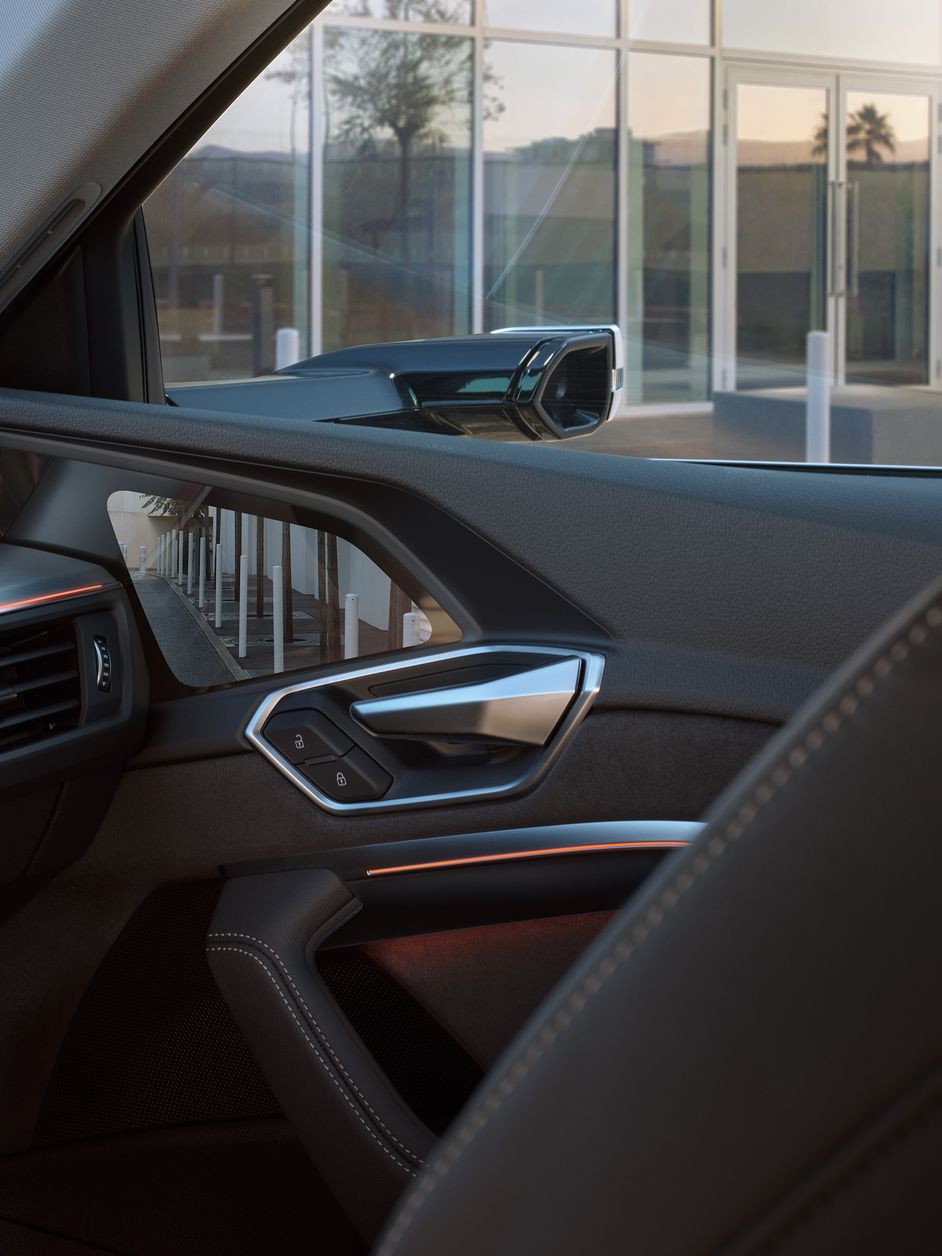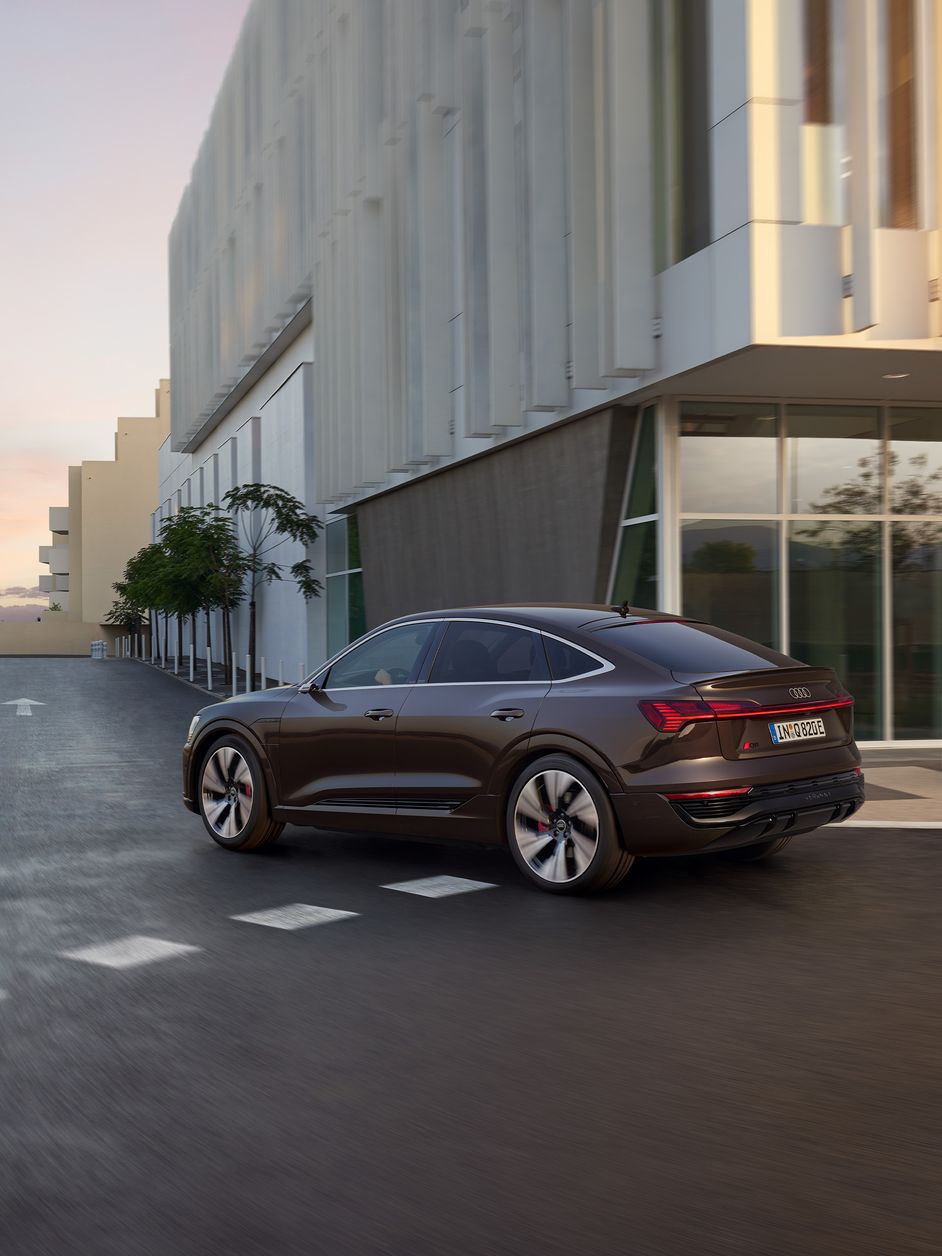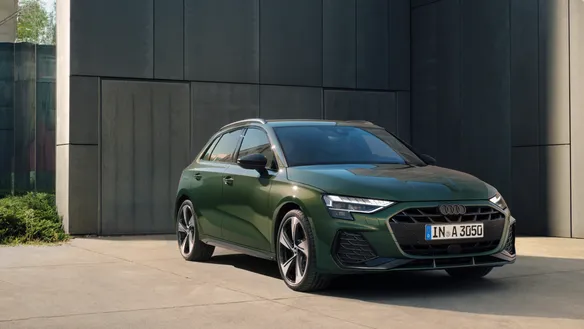Perfection of progress: the fully electric Audi Q8 e-tron
Audi Q8 e-tron: Power consumption (combined) in kWh/100 km: 25.3–20.1CO₂ emissions (combined) in g/km: 0CO₂ emission class: A
Audi Q8 e-tron: Power consumption (combined) in kWh/100 km: 25.3–20.1CO₂ emissions (combined) in g/km: 0CO₂ emission class: A

1. Range

1. Range
The Audi Q8 e-tron provides a long range thanks to its large battery capacity. For example, the Audi Q8 55 e-tron quattro has a high-voltage battery with a capacity of up to 114 kWh. This allows it to drive up to 600 kilometres on a single battery charge (according to WLTP).
When the battery charge level is low, further range potential can be exploited by activating Range mode in the MMI. Range mode limits the top speed to 90 km/h and lowers convenience functions such as automatic climate control or deactivates seat heating.
Audi Q8 e-tron: Power consumption (combined) in kWh/100 km: 25.3–20.1CO₂ emissions (combined) in g/km: 0CO₂ emission class: A
Audi Q8 55 e-tron: Power consumption (combined) in kWh/100 km: 24.4–20.6CO₂ emissions (combined) in g/km: 0CO₂ emission class: A
Audi Q8 e-tron: Power consumption (combined) in kWh/100 km: 25.3–20.1CO₂ emissions (combined) in g/km: 0CO₂ emission class: A
Audi Q8 55 e-tron: Power consumption (combined) in kWh/100 km: 24.4–20.6CO₂ emissions (combined) in g/km: 0CO₂ emission class: A

2. Quick charging

2. Quick charging
Thanks to a charging capacity of up to 170 kW, the Audi Q8 e-tron can now be charged even faster at high-power charging stations. For the Audi Q8 55 e-tron quattro and the Audi SQ8 e-tron, this means that the traction battery charges from 10 to 80%¹ within 31 minutes. The stable charging curve, with high charging power over a wide range of the charging process, also shortens downtimes at the charging station.
With the e-tron route planner, charging stops are integrated into the route in such a way that the charging power can be used effectively. The e-tron route planner is part of Audi connect Navigation & Infotainment (depending on country-specific availability).
Audi Q8 e-tron: Power consumption (combined) in kWh/100 km: 25.3–20.1CO₂ emissions (combined) in g/km: 0CO₂ emission class: A
Audi Q8 55 e-tron: Power consumption (combined) in kWh/100 km: 24.4–20.6CO₂ emissions (combined) in g/km: 0CO₂ emission class: A
Audi SQ8 e-tron: Power consumption (combined) in kWh/100 km: 28–25.2CO₂ emissions (combined) in g/km: 0CO₂ emission class: A
¹The charging time of the battery can vary depending on various factors such as the ambient temperature, the use of other country specific plugs and the use of the preconditioning function (e.g. a remote controlled climate control of the vehicle or the use of the e-tron route planner). When using household plugs, the charging power is limited by the e-tron charging system.
Audi Q8 e-tron: Power consumption (combined) in kWh/100 km: 25.3–20.1CO₂ emissions (combined) in g/km: 0CO₂ emission class: A
Audi Q8 55 e-tron: Power consumption (combined) in kWh/100 km: 24.4–20.6CO₂ emissions (combined) in g/km: 0CO₂ emission class: A
Audi SQ8 e-tron: Power consumption (combined) in kWh/100 km: 28–25.2CO₂ emissions (combined) in g/km: 0CO₂ emission class: A
¹The charging time of the battery can vary depending on various factors such as the ambient temperature, the use of other country specific plugs and the use of the preconditioning function (e.g. a remote controlled climate control of the vehicle or the use of the e-tron route planner). When using household plugs, the charging power is limited by the e-tron charging system.

3. Digitalisation

3. Digitalisation
Of course, the Audi Q8 e-tron has state-of-the-art connectivity, such as in the myAudi app (depending on country-specific availability). It provides information at all times about the current charge status of the traction battery and the current parking position of the vehicle. The app also serves as a remote control to adjust the interior temperature before starting a journey and to unlock or lock the Audi Q8 e-tron.
Audi Q8 e-tron: Power consumption (combined) in kWh/100 km: 25.3–20.1CO₂ emissions (combined) in g/km: 0CO₂ emission class: A
Audi Q8 Sportback e-tron: Power consumption (combined) in kWh/100 km: 24.3–19.5CO₂ emissions (combined) in g/km: 0CO₂ emission class: A
Audi Q8 e-tron: Power consumption (combined) in kWh/100 km: 25.3–20.1CO₂ emissions (combined) in g/km: 0CO₂ emission class: A
Audi Q8 Sportback e-tron: Power consumption (combined) in kWh/100 km: 24.3–19.5CO₂ emissions (combined) in g/km: 0CO₂ emission class: A

4. Aerodynamics

4. Aerodynamics
The optional virtual exterior mirrors of the Audi Q8 e-tron ensure an improved drag coefficient and can thus contribute to an improved range for the fully electric SUV and its Sportback versions. They feature small cameras that project images onto 7-inch OLED displays inside the vehicle. In addition, they ensure razor-sharp detection of vehicles approaching from behind, regardless of any headlight reflections.
Audi Q8 e-tron: Power consumption (combined) in kWh/100 km: 25.3–20.1CO₂ emissions (combined) in g/km: 0CO₂ emission class: A
Audi Q8 e-tron: Power consumption (combined) in kWh/100 km: 25.3–20.1CO₂ emissions (combined) in g/km: 0CO₂ emission class: A

5. Driving experience

5. Driving experience
Fully electric quattro performance in the Audi Q8 e-tron as standard ensures high driving stability and superior traction. The electric all-wheel drive regulates the ideal distribution of drive torque on both axles in a manner that is permanent and fully variable, responsive and precise. As a result, it combines the efficiency of single-axle drive with the driving dynamics and traction of all-wheel drive.
When driving at lower speeds, the Audi Q8 e-tron uses only the rear electric engine for propulsion. If the driver requests more power than it can provide, the control units activate the engine on the front axle. In many situations, this activation takes place ahead of time, before slippage occurs on slippery roads or during fast cornering, or the car understeers or oversteers.
In addition, electric torque vectoring regulates the shifting of torques between the rear wheels in just a few milliseconds. When the car turns quickly into a corner, the electric engine allocates additional torque to the outer rear wheel, while the inner rear wheel is braked accordingly.
Audi Q8 e-tron: Power consumption (combined) in kWh/100 km: 25.3–20.1CO₂ emissions (combined) in g/km: 0CO₂ emission class: A
Audi Q8 e-tron: Power consumption (combined) in kWh/100 km: 25.3–20.1CO₂ emissions (combined) in g/km: 0CO₂ emission class: A

6. Performance

6. Performance
The advanced and prestigious Audi Q8 e-tron SUV provides impressive driving dynamics: in the Audi Q8 55 e-tron quattro version, it accelerates from 0 to 100 km/h in 5.6 seconds and reaches a top speed of 200 km/h (Audi Q8 55 e-tron: Power consumption (combined*) in kWh/100 km: 24.4–20.6; carbon emissions (combined*) in g/km: 0. Information on fuel/power consumption and CO₂ emissions with ranges depending on the selected equipment of the vehicle. Only consumption and emission values according to WLTP and not according to NEDC are available for the vehicle).
The various driving modes of the adaptive air suspension, fitted as standard, such as efficiency or sport, can be easily selected via Audi drive select. The steering and cornering of the Audi Q8 e-tron are also improved through enhanced transverse dynamics.
Audi Q8 e-tron: Power consumption (combined) in kWh/100 km: 25.3–20.1CO₂ emissions (combined) in g/km: 0CO₂ emission class: A
Audi Q8 e-tron: Power consumption (combined) in kWh/100 km: 25.3–20.1CO₂ emissions (combined) in g/km: 0CO₂ emission class: A

7. Lighting design

7. Lighting design
Various lighting accents complement the new look of the Audi Q8 e-tron. An optional continuous light strip in the singleframe grille at the front and the specific signature daytime running lights also outwardly reflect its progressive technology.
The optional digital Matrix LED headlights fine-tune the character of the Audi Q8 e-tron and offer impressive functions. The adaptive light distribution, the lane light and the orientation light provide support to the driver, while the hazard alert projects a warning symbol onto the road and the coming-home/leaving-home function of the Audi Q8 e-tron offers five dynamic lighting settings that can be selected via the MMI.
Audi Q8 e-tron: Power consumption (combined) in kWh/100 km: 25.3–20.1CO₂ emissions (combined) in g/km: 0CO₂ emission class: A
Audi Q8 e-tron: Power consumption (combined) in kWh/100 km: 25.3–20.1CO₂ emissions (combined) in g/km: 0CO₂ emission class: A

8. Sustainability

8. Sustainability
Audi is pursuing a consistent decarbonisation strategy. Not only is the entire production of the Audi Q8 e-tron net carbon-neutral², but battery cell production is also carried out with 100% green energy.
Audi Q8 e-tron: Power consumption (combined) in kWh/100 km: 25.3–20.1CO₂ emissions (combined) in g/km: 0CO₂ emission class: A
²Audi defines net carbon neutrality as a status where, despite having exploited other possible reduction measures in relation to CO2 emissions caused by our products or activities, remaining and/or currently unavoidable CO2 emissions in connection with the supply chain, manufacturing or recycling of our vehicles are, at least in terms of quantity, offset by voluntary compensation projects worldwide. CO2 emissions generated during the operational phase of a vehicle (i.e. as of the time the vehicle is handed over to the customer) are not taken into account.
Audi Q8 e-tron: Power consumption (combined) in kWh/100 km: 25.3–20.1CO₂ emissions (combined) in g/km: 0CO₂ emission class: A
²Audi defines net carbon neutrality as a status where, despite having exploited other possible reduction measures in relation to CO2 emissions caused by our products or activities, remaining and/or currently unavoidable CO2 emissions in connection with the supply chain, manufacturing or recycling of our vehicles are, at least in terms of quantity, offset by voluntary compensation projects worldwide. CO2 emissions generated during the operational phase of a vehicle (i.e. as of the time the vehicle is handed over to the customer) are not taken into account.





